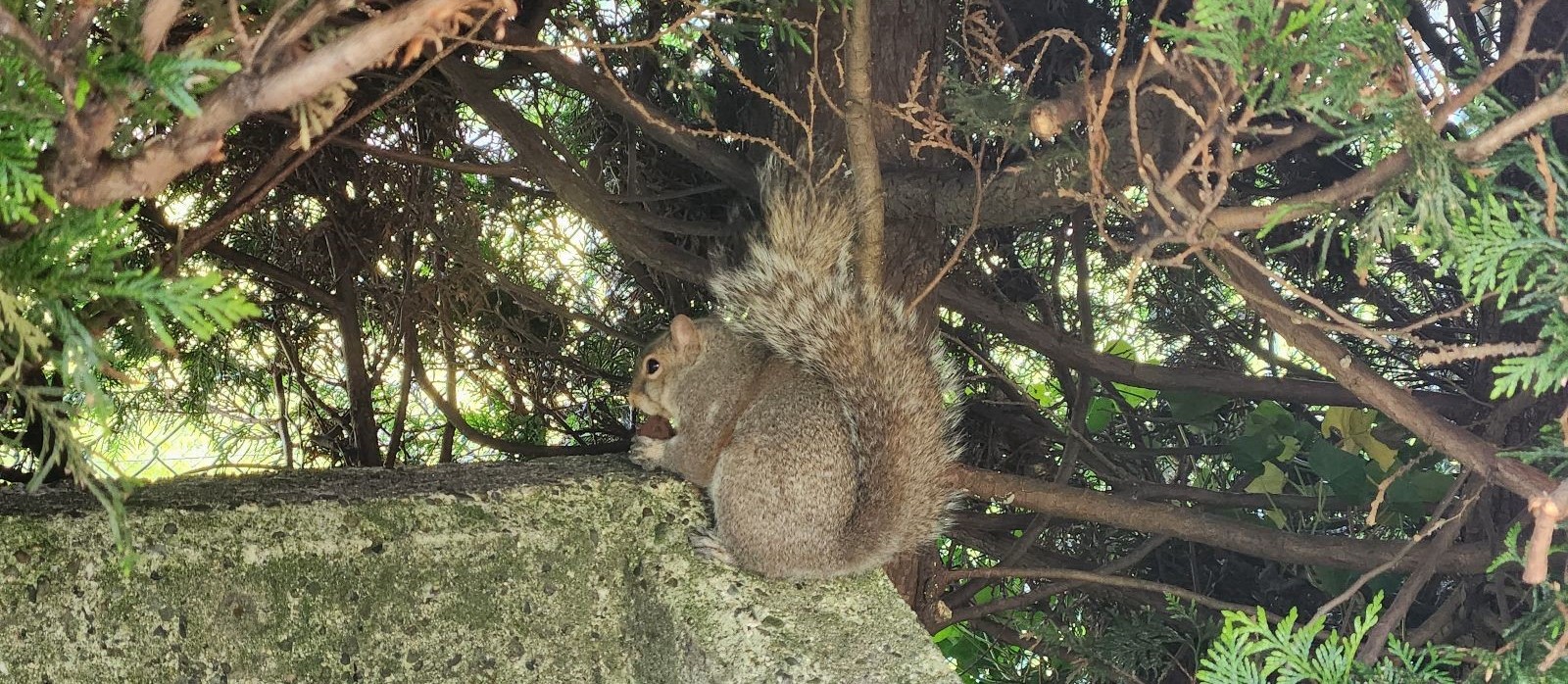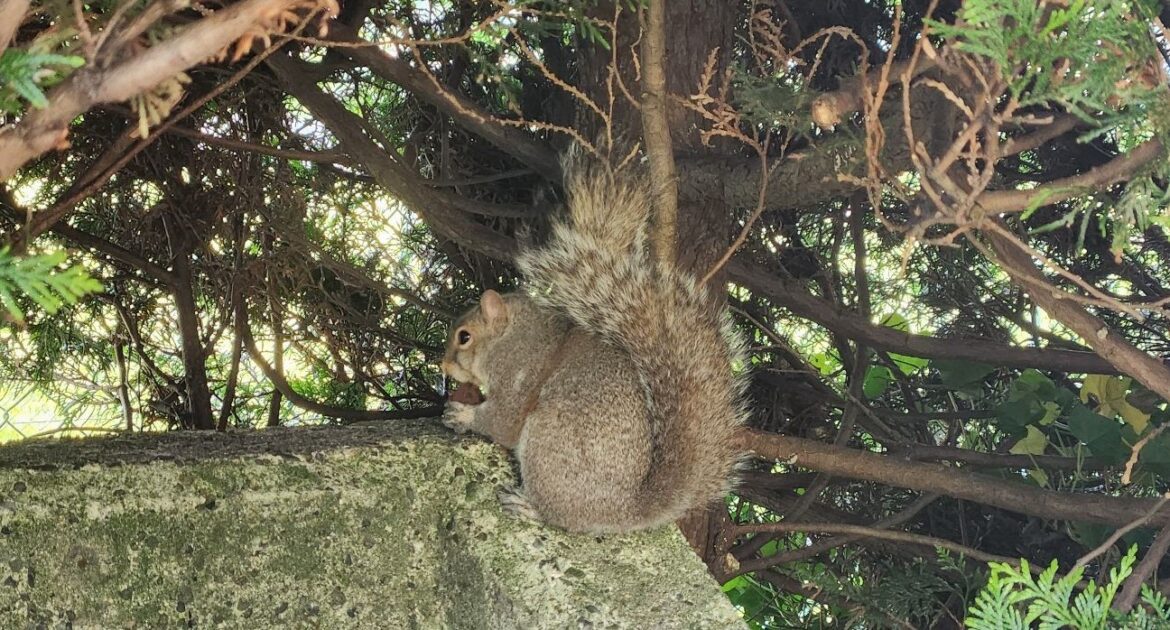You step outside on a crisp autumn morning and spot a squirrel darting across your yard with a mouth full of acorns.
Then another one scampers up a tree, tail twitching with excitement. You might wonder why these furry little animals seem so busy all of a sudden.
The answer is simple: squirrel behavior in the autumn is all about getting ready for winter.
As the leaves change colors and temperatures drop, squirrels become nature’s busiest workers. They’re not just running around for fun—they’re following millions of years of instinct that helps them survive the cold months ahead.
What squirrels do in the fall might look crazy to us, but it’s actually very smart planning.
If squirrels are getting a little too close to your home this fall, Skedaddle Humane Wildlife Control in Marietta is here to help. We use safe and humane methods to keep your home squirrel-free while protecting these amazing animals.
Let’s explore why these small animals get so active when autumn arrives. You’ll learn about their amazing memory skills, their sneaky food-hiding tricks, and why squirrels preparing for the winter work harder than most people getting ready for the holidays.
The Great Autumn Food Hunt
When fall arrives, squirrels switch into high gear. Their main job is finding food—lots and lots of food. But they’re not eating everything right away. Instead, they’re like tiny grocery shoppers stocking up for a really long winter.
Squirrels love nuts, and autumn is nut season. Acorns, walnuts, hickory nuts, and pecans all fall from trees during these cooler months. You’ll see squirrels stuffing their cheek pouches until they look like furry balloons. They can fit several nuts in their mouths at once.
But nuts aren’t their only target. Squirrels also gather:
- Seeds from pinecones
- Berries and small fruits
- Tree bark (yes, they eat bark!)
- Mushrooms and fungi
- Bird eggs when they can find them
These smart animals know that winter food will be hard to find. Snow will cover the ground, and most trees won’t have any nuts or fruits. That’s why autumn is so important for their survival.
Master Food Storage Skills
Here’s where squirrels get really impressive. They don’t just collect food—they hide it in hundreds of different places. This behavior is called “scatter hoarding,” and it’s like having secret food banks all over their neighborhood.
A single squirrel might bury over 3,000 nuts in one autumn season. They dig small holes, drop in a nut or seed, and cover it up. Some squirrels even pretend to bury food in empty holes to trick other animals who might be watching. Talk about being sneaky!
Squirrel behavior in the autumn includes some amazing memory tricks:
- They remember where most of their buried treasures are located
- They use landmarks like rocks, trees, and fence posts to find their stashes
- They can smell their buried nuts through several inches of dirt and snow
- They space their hiding spots about 30 feet apart
Not every buried nut gets found again. The forgotten ones often grow into new trees, which means squirrels accidentally plant forests. Pretty cool, right?
Building Winter Homes
While they’re busy gathering food, squirrels also need to prepare their homes for winter. They don’t hibernate like bears, so they need warm, cozy places to sleep during cold nights and storms.
Tree squirrels build two types of homes. The first is called a “drey”—a leafy nest high up in tree branches. These nests look like messy balls of leaves and twigs, but they’re actually well-built shelters with thick walls and soft insides.
The second type is a den inside a tree trunk. Squirrels find hollow spots in old trees and line them with soft materials like:
- Shredded bark
- Moss and grass
- Feathers from birds
- Even bits of fabric they find
What squirrels do in the fall includes lots of home improvement projects. They’ll repair old nests, build new ones, and gather materials to make everything as warm and weatherproof as possible.
Growing Their Winter Coats
Just like you put on heavier clothes when it gets cold, squirrels preparing for the winter grow thicker fur coats. Their summer fur is thin and light, but autumn triggers their bodies to grow a second, warmer layer underneath.
This winter coat has special features:
- Dense undercoat for warmth
- Longer guard hairs that repel water
- Extra fluffy tail for wrapping around their body
- Tufted ears that protect against cold wind
Their tails are especially important. Squirrels use their big, fluffy tails like blankets, wrapping them around their bodies when they sleep. The tail also helps them balance when they’re jumping between tree branches covered in snow.
Getting Chubby for Cold Days
Another part of autumn preparation is putting on weight. Squirrels eat extra food to build up fat stores in their bodies. This fat works like a built-in heater and gives them energy when food is hard to find.
You might notice that autumn squirrels look rounder and chubbier than summer squirrels. That’s not because they’re being lazy—it’s because they’re being smart. The extra weight helps them stay warm and survive days when they can’t leave their nests to look for food.
Their bodies naturally slow down their metabolism in winter, which means they don’t need to eat as much. Combined with their stored fat and buried food supplies, this helps them make it through the coldest months.
Territory and Social Changes
Squirrel behavior in the autumn also includes some interesting social changes. During spring and summer, squirrels are often busy raising babies and might be more territorial. But in fall, they sometimes become more tolerant of other squirrels.
This makes sense when you think about it. If a really bad storm hits, squirrels might need to share warm shelters. Adult squirrels might even huddle together in one nest during the coldest nights, sharing body heat to survive.
However, they still guard their food stashes carefully. A squirrel will chase away other squirrels (and chipmunks) who get too close to their buried treasures. It’s like having a secret savings account—you don’t want anyone else spending your money!
Staying Active All Winter
Unlike animals that hibernate, squirrels stay somewhat active all winter long. That’s why their autumn preparation is so important. They need enough stored food and energy to keep going for months.
On warm winter days, you might see squirrels coming out to:
- Dig up some of their buried nuts
- Look for any available fresh food
- Exercise and stretch their muscles
- Check and repair their nests
What squirrels do in the fall sets them up for this winter lifestyle. They can’t sleep through the cold months, so they need to be completely prepared with food, shelter, and warm clothing (their fur coats).
Why They Seem So Crazy
Now you know why squirrels seem extra busy and maybe a little crazy during autumn. They’re not actually going crazy—they’re working incredibly hard to prepare for winter survival. Their hyperactive behavior is driven by powerful instincts that have kept squirrels alive for thousands of years.
When you see a squirrel frantically burying nuts in your yard or racing around with cheeks full of acorns, remember that you’re watching an amazing survival strategy in action. These small animals are following a detailed plan that’s more organized than many human preparations for winter.
Professional Help When Squirrels Get Too Close
Understanding squirrel behavior in the autumn and what squirrels do in the fall helps us appreciate these remarkable animals. However, sometimes squirrels preparing for the winter decide that your attic or garage looks like the perfect place to store food or build a nest.
When squirrels move into your home, it’s time to call professionals. At Skedaddle Humane Wildlife Control in Marietta, our experts understand squirrel behavior and use humane methods to help these animals find better homes. Our one-way doors allow squirrels to leave your property safely while preventing them from returning.
Don’t let squirrel problems stress you out this autumn season. Our team provides effective, ethical solutions that protect both your home and the wildlife around it.
Ready to learn more about keeping squirrels where they belong—outside? Request an estimate today and let our professionals handle your wildlife concerns with care and expertise.




